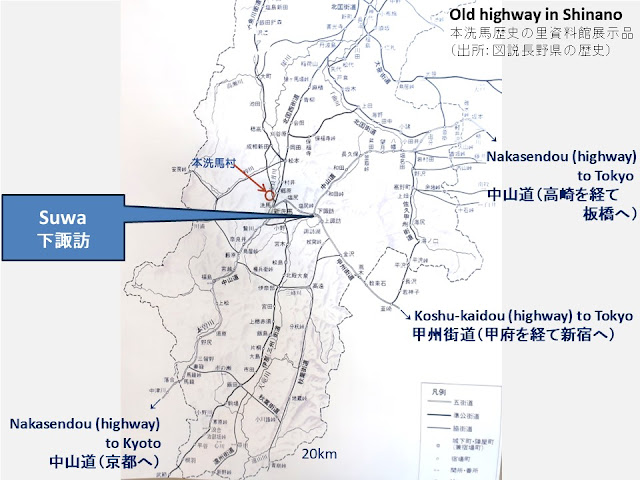Lake Suwa in central Japan (Nagano pref.) gathers water in the mountainous region. It pours into the Pacific via Tenryu River (213km, 9th longest river in Japan).
The lake has rich fishery resources which are
precious protein source for locals. The museum shows us not only how to
catch fishes, but also entertainment (skating) and prayer to the lake.
周辺の川からの水が流れ込む諏訪湖は、魚=山間部の貴重な蛋白源の宝庫です。さまざまな方法で魚を獲り、スケートを楽しみ、御神渡りする神に祈った諏訪の人々の様子がよくわかります。諏訪湖の水は天竜川を経て太平洋に注ぎます。
The first panel says Suwa people are familiar with the lake even though sometime struggle with it.
最初のパネルには、諏訪の人々は諏訪湖に親しみ、時に闘いながら生きてきたと書かれています。
Wooden boats and fishing equipment are displayed. A model and an old photo show us how to use it. It’s understandable.
漁業用のまるた舟と漁具が展示され、漁法が模型と古写真で展示されていて、よくわかります。
Nets are commonly used. Casting net is eye-catching (upper left). Even while the lake is frozen, they set the net under the ice. It looked plain, however, was a fruit of their efforts.
網を使った漁法では、投網が華やかですね(左上)。結氷時には氷の下に網を下ろすさし網漁もあったそうです。地味ではありますが工夫のかたまりですね。
Blade was attached under traditional shoes (geta), ice skates! Those were invented there in 1906. You can try them (upper left).
下諏訪町は下駄スケートの発祥の地。フィギュアの靴を真似て1906年に作られました。板の裏にブレードを付けます。履けますよ(左上)。
Children (upper right) and students (upper left) enjoyed skating. Japanese couldn't come up with the idea of skating, which was originated in Nederland in the 13th century, in order to transfer on frozen canals.
スケートで遊ぶ子どもたち(右上)や女学生さん(左上)の写真も展示されています。楽しそうですね。日本人は思いつかなかったことでした。スケート発祥の地はオランダで、13世紀には移動手段として凍った運河の上を滑ったそうです。
Cracks show up on a very cold day in winter (lower right). The phenomenon is called “Omi (deity) Watari (crossing the lake)”. It is considered the passage of the Suwa deity, so the Shinto ritual is performed (upper and under left). There are many deities in Japan.
凍った諏訪湖で湖面の氷が押し合い、氷が一列にせり上がる御神渡り。ジオラマで見られます。御神渡りがあると神事(左上)が行われます。日本は神様が多い国、私は好きです。
Special exhibition : Mounds of rebel samurai、浪士塚160周年(企画展、2024年8~11月)
The rebel troop (around a thousand of soldiers) advanced to Kyoto in 1864. The local regular army (around eight hundred soldiers) tried to quit them. Fifteen of the rebel troop were killed and eleven of the regular army were done. Even hunters were summoned and took role of reconnaissance personnel; the document at lower right is the evidence. The exhibition was held from August to November of 2024.
1864年に天狗党が水戸から京を目指して進軍してきました。下諏訪でも合戦が起こりました。天狗党(約1000人)の死者は15名、諏訪藩・松本藩連合軍(約800人)の死者は11名とされています。右下は偵察の役を担った猟師の成果報告。かり出されたのですね。
Tombs of samurai of the rebel troop were built and memorial service for them were held even until now; it’s really Japanese. The exhibition was held as the 160th anniversary. The strategist of the regular army wrote that he felt sympathy for then a lot after their surrender. Did he have sympathy of their mission? I’m not sure.
戦死した水戸浪士の墓を作り今も慰霊祭を行っています。訪問時は160周年。日本人らしいですね。諏訪藩の軍師が、戦いを記録した書も残っていました。天狗党の投降を知ると「同情に余りある」と書き残しました。志に感銘したのか、どういう思いで戦ったのでしょうか。
The exhibition area above is about a poet “Shimaki Akahiko (1876-1926)” from Suwa.
当地出身の歌人・島木赤彦(1876-1926)の記念館が併設されています。
The museum was designed by Ito Yoyoo, who is a renowned architect and is from Suwa.
建物はあの伊東豊雄の設計です。2歳から中学3年まで下諏訪町で過ごしました。
We can see Lake Suwa from the lobby at the second floor.
二階のロビーからは諏訪湖を一望できます。
Reference、参考記事:Shimo-Suwa History and Folklore Museum
下諏訪町立歴史民俗資料館
下諏訪町には、甲州街道の終点であり、中山道の宿場町である下諏訪宿があります。
Official website: https://www.town.shimosuwa.lg.jp/www/contents/1680826406613/index.html
(in Japanese. Automatic translation is attached), accessed in December, 2024
Visited in March, 2024
Previous post (museum in the neighboring city): Suwa
City Museum (2/2)、諏訪市博物館(part 2)
Next post (museum in the neighboring city): Chino City Yatsugatake Museum、茅野市八ヶ岳総合博物館














Comments
Post a Comment